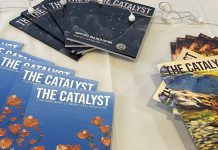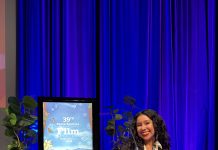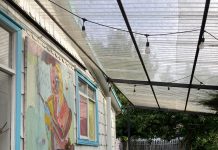Quincy Lee
Staff Writer
How fast can you transport something from L.A. to San Francisco? Engineering students at UCSB are building a pod that could go around 500 miles in approximately 30 minutes.
The SpaceX Hyperloop Competition, proposed by Elon Musk as an alternative to the California bullet train, is calling upon engineering programs to develop a reliable and efficient way to travel.
1,300 schools programs initially entered the competition. Currently, the UCSB Hyperloop team of 30 students and professors is among the final 23 teams.
As the school year comes to a close, the engineering students are putting the final touches on their pod, a prototype for the Hyperloop transport. They will submit this prototype to the SpaceX competition this August.
Their 400-pound pod is approximately the size of a refrigerator on its side. It will go inside the air-tight, vacuum sealed, pipe built by SpaceX, like a subway car inside the tube.
The lack of air resistance will allow the pod to travel much faster and require less propulsion than if it was not in a vacuum. Think how fast a spitball goes when going through the straw.
In order to further reduce friction, the engineering students have designed the pod to levitate above the track. A magnet placed on a spinning motor will raise the pod off the ground.
Using this levitation component will allow the pod to be transported efficiently. “Once the pod is in the metal tube and the air is taken out, we have frictionless, hovering transport,” said Hyperloop team leader and graduate student, Celeste Bean.
Known as a maglev, short for magnetic levitation, the pod’s hovering system is an example of the rapid advances of modern technology. “This design is a scalable demonstration of magnetic levitation,” said Paymon Shariat-Panahi, a fourth-year mechanical engineering student and technical manager of the UCSB Hyperloop team.
With students whose backgrounds’ range from electrical to mechanical engineering, the UCSB Hyperloop group divided themselves into task forces to tackle the more specialized aspects of building this transport pod.
Although the vacuum allows the pod to travel efficiently, the lack of air circulation makes overheating a difficult hurdle in this project. “Like any machine, the maglev engines heat up, but in this tube, there is no airflow to cool it down,” said Jared Kai Caindec, leader of the thermodynamics section of the Hyperloop group.
Making sure the overheating of the batteries doesn’t harm the electronics within the pod, Caindec and the thermodynamics team store the Maglev batteries and motor controllers in aluminum boxes surrounded by PCM wax.
The wax reduces heat transport to the more vulnerable parts of the pod, such as the circuit board and the electronic sensors. The sophisticated electronics continuously monitor the pod’s speed and its GPS location, as well as the inner workings of the maglev motors.
The pod they built contains multiple sensors to double-check all of these measures. In addition, the students have been meticulously testing the parts to work out the kinks and ensure success in the SpaceX competition.
The students also developed a braking system that automatically engages when the pod is a set distance from the destination. Slowing down this pod takes a lot of force, 5010 Newtons specifically, and requires the pod’s sensors to be finely tuned.
To ensure safety in case the magnetic motors fail, the students outfitted their pod with four wheels. These wheels have the same durability as those on the top drag-racing cars and help the pod withstand impact at 330 miles per hour.
The technology that these students put into the refrigerator sized hyperloop pod is something that Back to the Future merely dreamed about. The SpaceX competition, and the hyperloop in general, will expand the transportation industry, in part due to the success of UCSB Engineering students.
“The work put in by these engineering students will be instrumental in training future students and for continued formative experience as part of the UCSB Engineering program” concluded Shariat-Panahi.







Is the GPS signal precise enough at the Hyperloop speeds?
How the GPS signal will be caught in tunnels?
In what century they complete few kilometers of the DevLoop and finally run some actual tests?
Comments are closed.